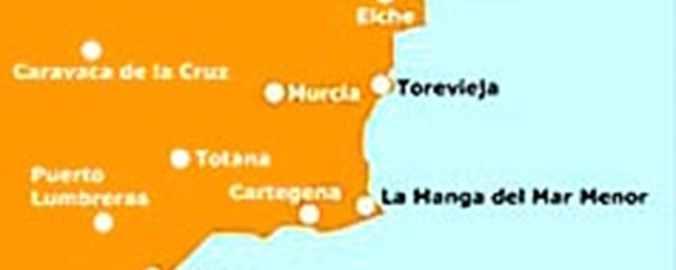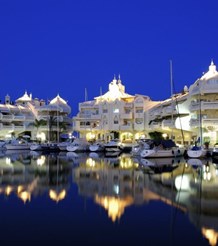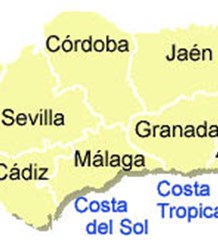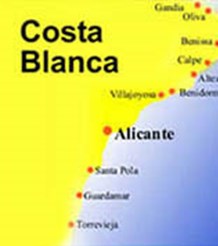
Costa Calida Information
The Costa Calida lies in the south east of the Iberian peninsula with the Costa Blanca to the north and the Costa Almeria to the south. It is approximately 155 miles long and has at least 315 days of sunshine a year. In winter the minimum temperatures are around 12-14°C/maximum 20-22°C and in summer minimum temperatures are around 20-22°C/maximum 30-35°C.
The Mar Menor, Europe's largest salt-water lake, is on this coast. It covers over 170 sq km and is separated from the Mediterranean by a 13 mile peninsular. There are not many regions that have the unique situation of a lake and the sea close by.
Many people visit the lakes daily to apply mud to their bodies and then wash it off in the Mar Menor. It is believed that this process relieves aches and pains and is especially popular with those who suffer from arthritis and muscular problems. The lakes abound with wildlife and many thousands of flamingos stop there during their autumn migration. Some of the most important villages are San Pedro del Pinatar, Los Alcazares, Los Narejos, Islas Menores, Mar de Cristal and Playa Honda.
Murcia is the capital of the region. It is surrounded by a cultivated fertile plain. The most important monument is the cathedral, whilst other outstanding monuments include the Episcopal Palace, the Casino, several churches and 19th century architecture. Among the various museums, there is one dedicated to the works of the image-maker Francisco Salzillo.
La Manga, is the largest tourist center in the region. It is a narrow, sandy spit of land that stretches between Mar Menor and the Mediterranean. There are 22 km of beaches between 100 and 800 meters in width. It is cocooned by the pine-covered Murcian hills and surrounded by lemon groves and thousands of palm trees. La Manga covers an area the size of Monaco and features 3 golf courses, one of Europe 's finest tennis centers and many other excellent sporting and recreational facilities. At the heart of the resort lies the stunning Hyatt Regency Hotel complex, whilst small village-like clusters of villas and apartments populate the surrounding hillsides.
The Costa Calida is just 25 kilometers from Murcia (San Javier) Airport and 120 kilometers from Alicante with the provinces of Alicante and Valencia to the north and Almeria and Granada to the west.
Murcia Area Information
Murcia is located in south eastern Spain on the Iberian Peninsular in an area known as the Costa Calida. The region occupies an area of 11,320 km2 and borders with the provinces of Albacete in the north, Alicante in the east and Granada, Albacete and Almeria in the west.
Murcia is located in south eastern Spain on the Iberian Peninsular in an area known as the Costa Calida. The region occupies an area of 11,320 km2 and borders with the provinces of Albacete in the north, Alicante in the east and Granada, Albacete and Almeria in the west.
The population of Murcia is approximately 340,000 in the capital and 600,000 when the outlying areas are included. Murcia has been the capital of the province since 1838.
It has 170 km of coast, which consists of many small bays and rocky shores. There is a strip of land 20 to 30 km long in Murcia, which separates the Mediterranean Sea and the salt water lake of Mar Menor.
The Murcia region has excellent links with the rest of Spain with a full network of communications. Investment has been made to improve and enlarge the road network, in particular to the construction of motorways which have made it possible to enhance links between different towns within the region and at the same time giving good contact with the rest of Spain.
The Mar Menor is a huge (135 square kilometers) salt-water lagoon, separated from the Mediterranean by La Manga del Mar Menor. The average depth of the Mar Menor is four meters and its maximum seven with a gently sloping bed. The marshes around the Mar Menor are a conservation area owing to the huge diversity and numbers of visiting birds.
The Mar Menor's high salt content makes it a safe place to swim. The mineral-rich waters of the Mar Menor are believed to have therapeutic effects, creating a significant spa tourism industry. The sludge in the salt-pans of Lo Pagán to the north of the Mar Menor is also credited for its health benefits.
The Murcia region has excellent links with the rest of Spain and boasts a complete network of communications. Much investment has gone into the improvement of the road network, in particular to the construction of motorways.
There are many projects to further improve communications with the area. One is the railway network, with the imminent incorporation of the high-speed train (AVE) connecting Murcia with Madrid and the Valencia region. The other is the project for a new regional airport, equipped with state-of-the-art national and international air transport infrastructures.
There is a port at Cartagena, situated at the hub of the principal Mediterranean commercial and passenger sea routes. This port receives a steady flow of visitors on pleasure cruises throughout the year. It is fully equipped with every amenity for a pleasant stop-off point on Mediterranean maritime routes.
Murcia has a typical Mediterranean climate with hot summers and mild winters. In July and August temperatures reach around 40C and drop to around 10C in the winter, with over 300 days of sunshine a year.
Murcia is built near the center of a low-lying fertile plain known as the huerta or market garden of Murcia and is surrounded by mountains.
Inland Murcia is ideal for nature lovers owing to the mountains and woodland areas. There are fields, forests and valleys in 18 natural parks, making it ideal for walking, climbing and all other mountain sports. There is abundant wildlife and bird life for animal lovers.
Coastal Murcia is ideal for water sports devotees as it is one of the best places in the world for practicing sailing, canoeing, swimming, water-skiing, jet-skiing, kite surfing, windsurfing and every type of water sport. Numerous clubs, ports and sailing schools serve the area. Murcia is famous for its golf courses with several world-class courses in the area, the most well known being La Manga.
The city of Murcia is modern city and offers many activities for recreation. Its excellent cuisine and warm climate makes it unforgettable. A huge choice of bars, restaurants and shops cater for every nationality and taste.
Murcia was founded in 825 AD by Abd ar-Rahman II and had the name Medinat Mursiya. The Arabs created a complex network of irrigation channels from the Segura River, which made the town prosperous. It was described by Muhammad al-Idrisi in the 12th century as populous and strongly fortified.
The city flourished in the 18th century, mainly due to the boom of the silk industry. Many of its churches and monuments were built during this period.
The town and its surroundings suffered from floods in 1651, 1879 and 1907, though the construction of a wall has helped to keep the Segura River in its bed.





